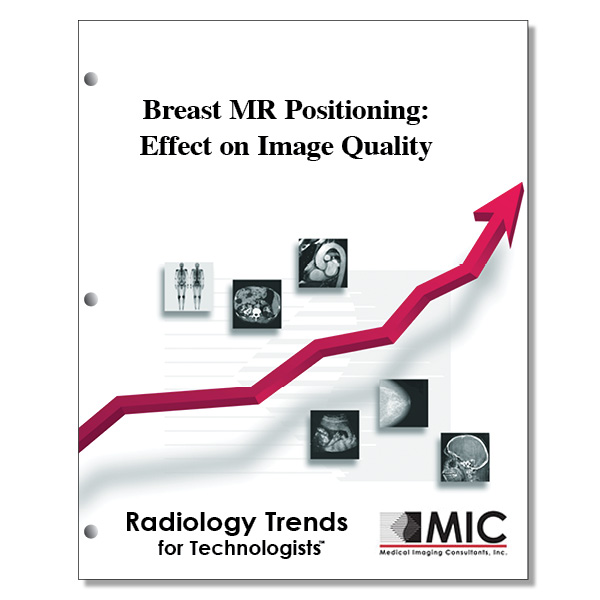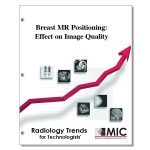

Breast MR Positioning: Effect on Image Quality
Suggestions and techniques for improved patient positioning in breast MR imaging are presented.
Course ID: Q00428 Category: Radiology Trends for Technologists Modalities: Mammography, MRI3.0 |
Satisfaction Guarantee |
$34.00
- Targeted CE
- Outline
- Objectives
Targeted CE per ARRT’s Discipline, Category, and Subcategory classification for enrollments starting after May 31, 2023:
Magnetic Resonance Imaging: 3.00
Image Production: 0.50
Physical Principles of Image Formation: 0.50
Procedures: 2.50
Body: 2.50
Outline
- Introduction
- Positioning in Breast MR Imaging
- Use of Dedicated Breast MR Imaging Technologists
- Review of Prior Images
- Coil Setup
- Technique of Positioning the Patient in the Coil
- Guide the Patient into the Coil and Center the Breasts over the Center Bar
- Check Breast Position from the Lateral, Medial, and Top-Down Positions
- Repeat the Positioning Check with the Other Breast
- Position the Nipple in Profile
- Check the Triplane Localizer Images
- Artifacts Due to Improper Positioning and Their Causes
- Poor Superior Positioning
- Poor Fat Suppression
- Poor Medial Positioning
- Skin Folds
- Large Breasts
- Inferior Bulge
- Fat Saturation Pad
- Prior Surgery
- Implants
- Missed Cancer Due to Poor Positioning
- Pseudo Cancer Due to Improper Positioning
- Effect of Arm Position
- Positioning for MR Imaging-guided Procedures
- Review of Prior Diagnostic Images
- Using Padding to Roll the Patient
- Using Sponges to Bolster Breast Tissue
- Raising the Grid to Access Posterior Lesions
- Awareness of Altered Landmarks
- Examples of Difficult Access during MR Imaging-guided Intervention
- Core Biopsy of a Far Posterior Mass
- Wire Localization of an Axillary Mass
- Biopsy of Patients with Implants
- Biopsy of Medial Lesions
- Conclusion
Objectives
Upon completion of this course, students will:
- know when the importance of positioning for breast imaging was first realized
- know the most common reason for accreditation failure in mammography
- be able to list reasons for the success of MRI in detecting invasive malignancies of the breast
- understand the difficulties of positioning in breast MR imaging compared with other areas of the body
- be aware of the effect compression of breast tissue has on the enhancement of malignancies
- understand the authors’ recommendations for breast MR imaging technologists
- know what help can be provided by reviewing prior MR imaging studies
- be aware of artifacts that may result from using cloth linens
- understand how to position a patient for breast MRI using both hands
- know when the sternum should be positioned over the center bar of the breast coil
- know the best view for checking that the nipple is in profile
- understand the problems that might be caused if the nipple is not in profile
- know what to check on the triplane localizer before continuing the breast MR exam
- understand the artifact that can result from positioning the breast too far superiorly in the coil
- know the appropriate time to deal with skin folds
- know the term that describes the situation when large breasts overfill a coil
- be aware of artifacts that may be encountered in large-breasted patients
- be familiar with ways to avoid artifacts when imaging large breasts
- check for abdominal tissue in the breast coil before imaging
- know the chemical makeup of the fat saturation pad
- know where the use of fat saturation pads was first described
- be aware of the anatomy where fat saturation pads were first used
- know which type of anatomy benefits from the use of fat saturation pads
- be familiar with the characteristics of the liquid in fat saturation pads
- know which type of fat saturation pad is used for breast imaging
- know how often a fat saturation pad is used, in the experience of the authors
- understand how prior surgery or radiation therapy to the breasts can affect breast MRI
- know a method of dealing with bulging breast implants
- know why breast MRI is commonly done with the arms above the head
- be aware of the occasions that benefit from positioning the patient with arms at their side
- be able to list features to review on prior diagnostic images
- be familiar with lesions that can be accessed better with the patient rolled into an oblique position
- know when bolstering can help increase the safety of breast biopsy
- describe an approach for biopsy in a patient with implants
- describe a lesion location that requires the contralateral breast be moved out of the way
